The Secrets of Pigments
by Mig Jimenez
Many modellers use pigments (coloured powders) and pastels, but they
also have a lot of difficulty in knowing how to use them correctly: they
remain a bit of an enigma. With this article I will try not only to explain
how to use them, but also what they are and where they come from. So let's
discover the secrets of pigments.
What are pigments?
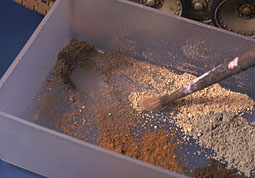
Pigments are essentially coloured powder, and are used to produce a full
range of colours. We can say pigments are a primary material, like petroleum
or coal. Using this powder, manufacturers produce all types of paints
and colouring material: enamels, acrylics, pastels, chalks, coloured pencils,
oils, etc.
The only thing that you need to add to the powder in order to make a
type of paint is an agglutinant. This varies between products: oil is
the agglutinant type used for oil paints, whereas Arabic rubber is the
type used for pastel chalks; but the powder always stays the same.
Pigment powder is extracted from different minerals, such as magnesium,
titanium, zinc, and also from mineral earth.
Are there different quality types?
The quality of a pigment is determined by two factors:
1. The purity of the pigment, which depends on the mineral of origin.
2. How fine the powder is. If the powder is coarse, with small stones
or debris, the pigment will be of poor quality. This depends on the factory
that produces it.
If you create pigment powder from pastel chalks using sandpaper, you
will get a poor quality pigment, because it will already contain the original
agglutinant material. For this reason, pigments are not the same as pastel
chalk powders.
The origin of the use of pigments in modelling
Powders have been used in modelling for many years. Modellers such as
Verlinden first used pastel powders for vehicles in a rudimentary way.
This technique is not new, and it has long been used to simulate dust
effects. I used to use my mother's make-up powder to create such effects
– but the only effect that I achieved was my mother's anger! The
next evolution came along, and I discovered pastels chalks. I rubbed the
coloured chalk stick with sandpaper and produced dry powder to apply to
my models.
But some years ago, I discovered that Japanese modellers used pigment
powder. Finally, I decided to manufacture my own coloured pigment for
use in modelling.
At present, pigments are a tool new to our hobby. Many modellers use
them, and some cannot do without them.
What are the secrets of pigments?
You can go to an art store, and buy a kilo of Magenta colour for 12–16
Euros (c.14-18 US Dollars, at time of writing). But in these stores they
only sell basic colours for artists. Modelers need specific colours for
their vehicles and planes - and we cannot use yellow or blue to create
dust or mud. This means that the secret of using pigments lies not in
the properties of the pigment itself, but in mixing them correctly to
create the required effect. And this is where the complexity lies too.
If the mixture is wrong, the final results will be disastrous.
Always remember, the colour you use is very important, and of course,
the pigment should be very finely produced.
What kind of effects can you achieve?
You can achieve a wide variety of effects: dust, mud (fresh or dry),
rust, smoke, ash, dirt marks, rain marks – and many more. Your imagination
is the limit. Some of the various techniques are illustrated in the image
below.
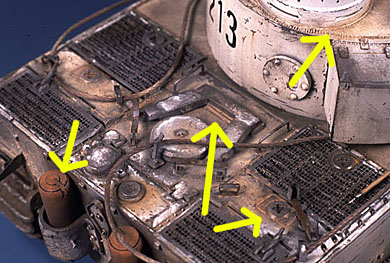
Are the techniques easy?
There are many different techniques when using pigments. Some are very
easy, but others are extremely complex. In general, the modeller can obtain
very good results quickly. In fact, pigments can replace older techniques
of replicating dust and mud, obtaining the same results in much less time.
The modeller who wants to work quickly, or who may want to produce good
results despite being of little experience, can choose to use pigments.
But the expert modeller can also integrate them into his or her select
painting techniques.
What are the basic pigment techniques?
There are two types of basic technique:
1. direct use
2. combined use.
In direct use, you can apply pigments directly with a paintbrush to create
the following results:
DESERT DUST: The pigment is applied directly to a matt
surface. If the surface is glossy, the powder can disappear with time.
See below:
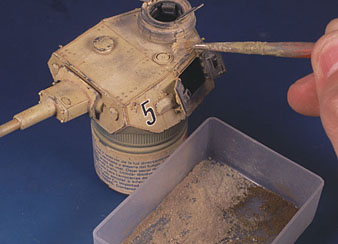
SMOKE: use black pigment directly. See below:
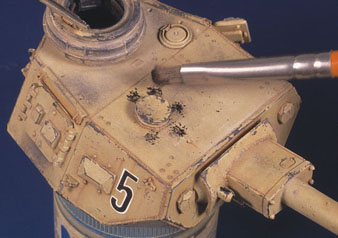
RUSTY SURFACES: as seen on exhaust pipes, or a rusty
vehicle. See below:
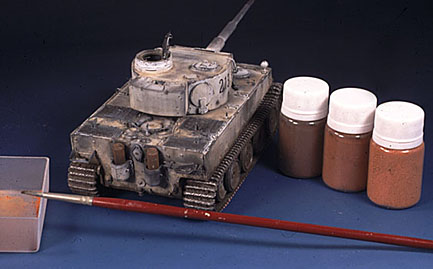
RUSTY TRACK: working directly with rust colours, you
can get very good effects on vehicles tracks. See below:
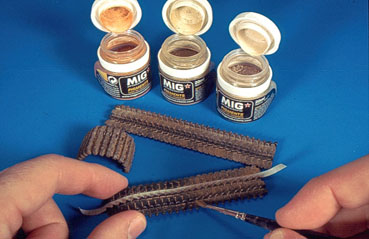
DIRT EFFECTS ON AIRPLANES: using different mixtures
of grey and brown, we can create subtle effects on different parts of
an airplane. See the two images below:
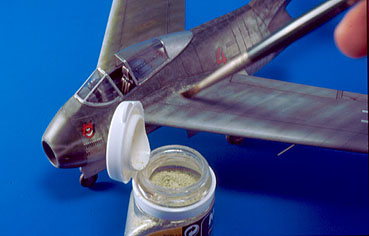
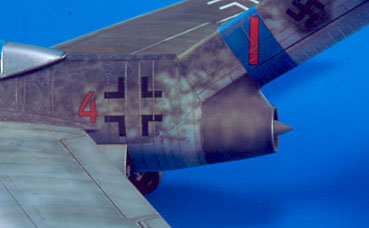
CITY DUST: the best way to produce the dust of a demolished
city is by applying pigments directly.
By combining the pigment with other products, you can duplicate the number
of effects, as shown in the list below:
DRY (EUROPEAN) EARTH: when earth is dried on a vehicle,
the aspect is different to the one generated by desert dust. You should
use a dark brown pigment. It is applied with a paintbrush on the surface
and a few drops of turpentine are added. The turpentine helps to fix the
powder on the surface. See the three images below:
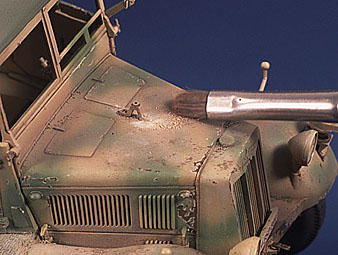
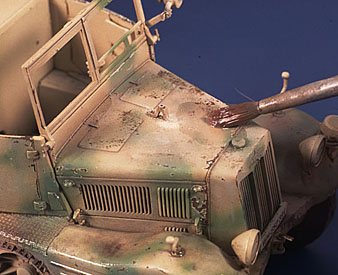
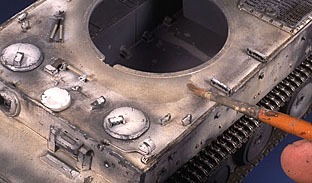
ASH: by mixing black and white, you can make small heaps
of powder under wheels, or wooden/rubber areas. Onc again, add a few drops
of Turpentine. See below:
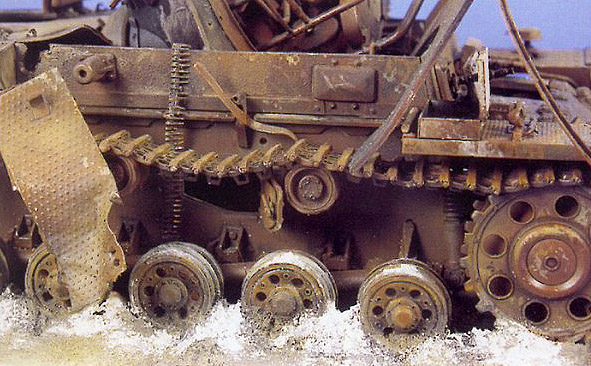
DRY MUD: to create this effect, mix plaster, brown clear
pigments, and acrylic resin. Apply the mixture with an old paintbrush.
Watch the drying process carefully, because unwanted effects can materialise.
Once dry, it is impossible to remove the mud. See the two images below:
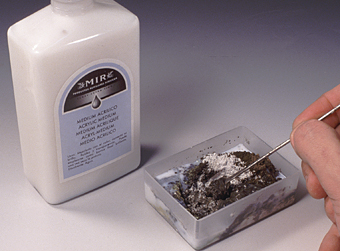
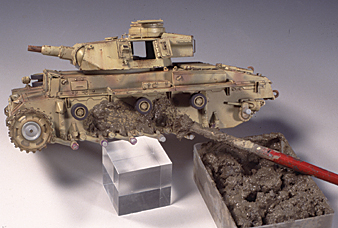
FRESH MUD: By mixing a large amount of dark brown pigment
and black color, varnish and plaster, you can achieve a very realistic
effect. You can also add earth, fine sand or small stones to the mixture.
See below:

LARGE RUSTY SURFACES: On large surfaces, the oxide should
be very matt, but it also needs to be fixed to the surface. Use alcohol
to fix the pigment instead of turpentine.
RAIN MARKS: An easy way to create this effect is to
blend pigments with water. This is easier to control than rain marks made
with Tamiya Buff.
COLOURED PUTTY: Sometimes colouring putty can produce
interesting results. Add the desired pigment directly plus solvent.
COLORED PLASTER: You can create brick buildings with
a characteristic reddish colour. You can also make bricks, or stones,
mixing different pigments when mixing plaster. The pigment doesn't alter
the properties of the plaster mixture .
FIGURE EFFECTS: On the uniforms of the soldiers and
crews, the quickest and most effective way to add dry mud and dirt is
to blend pigments with turpentine. See below:
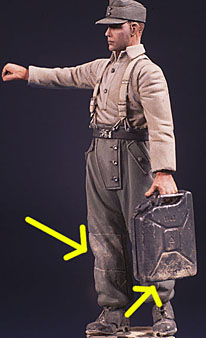
To round off, below you can see how you can make a countless number of
effects, such as dust and dirt on wheels, fuel drums, wood, vehicle seats,
glass, tarps etc.
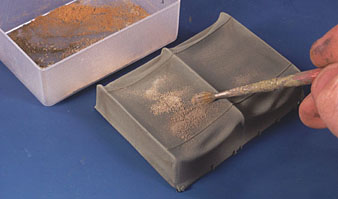
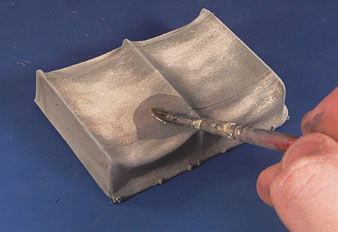
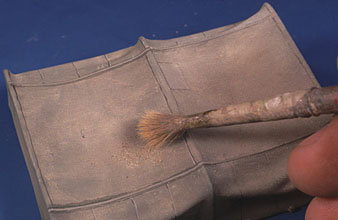
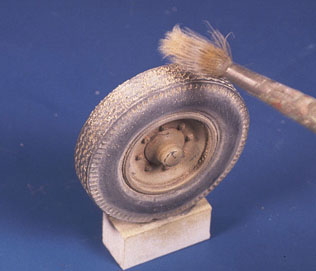
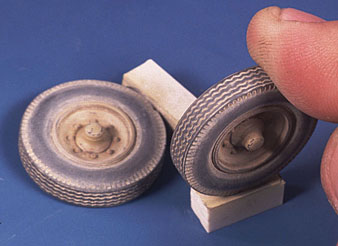
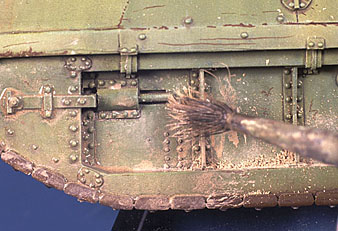
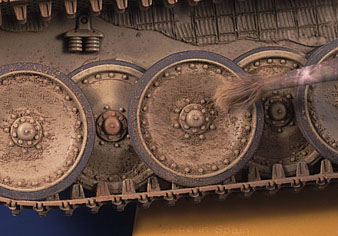
Mig Jimenez, May 2003
(Special thanks to Diego Lopez & Antonio Martin Tello)
|